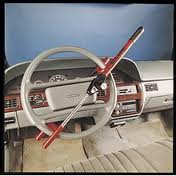 There’s an oft-mentioned statistic which says that somewhere in the United States, a car is stolen every twenty-five seconds. It is for this reason that automakers, insurance companies and the manufacturers of anti-theft devices consider it crucial to offer consumers a wide variety of methods to protect their cars, and why tracking technology is just as important as theft-deterrent technology in the current climate. After all, if you can’t prevent a car from being stolen, at least you can find out where it is, in order to recover it.
There’s an oft-mentioned statistic which says that somewhere in the United States, a car is stolen every twenty-five seconds. It is for this reason that automakers, insurance companies and the manufacturers of anti-theft devices consider it crucial to offer consumers a wide variety of methods to protect their cars, and why tracking technology is just as important as theft-deterrent technology in the current climate. After all, if you can’t prevent a car from being stolen, at least you can find out where it is, in order to recover it.
Modern anti-theft devices come in two general categories: theft deterrents and recovery systems. Let’s look at each:
Theft Deterrents
These devices may not always prevent a car from being stolen, but they make the theft incredibly difficult to accomplish. They include:
- The Club: More than a decade after its invention, the original Club remains the world’s most popular and effective steering wheel lock. Made to universally fit all kinds of vehicles (cars, trucks, SUVs and minivans), it’s constructed from steel that is resistant to hammering and sawing. It’s also relatively inexpensive, with the most expensive model coming in around $40, and other models available for as low as $20. The current LX version even includes laser encrypted key, and a manufacturer guarantee of up to $1,000.
- Car Alarms and Immobilzers: These work by either calling attention to an attempted theft (and hopefully driving away the prospective thief), or by literally cutting power to part of a car’s fuel or electrical system making the car really difficult to enter or move. They’re generally activated either with a small radio device, or through an on-board system that detects when an intruder starts tampering with the vehicle.
Recovery Systems
These devices may not prevent your car from being stolen, but they can help you (or local law enforcement) find your car once it’s been taken.
- OnStar: While we think of it, these days, as an entertainment and navigation system, OnStar was originally created as a safety device, and even though it’s currently available at different levels, the basic “Safe and Sound” package (which has been standard on many GM vehicles throughout North America since 2007) includes a complete range of anti-theft technology including a stolen vehicle location system, remote door unlocking, and remote horn and light activation. Other features include diagnostics, emergency services, and accident assistance, including an automatic notification of airbag deployment.
- LoJack: This is still the industry standard for vehicle location, thanks to the manufacturer’s decision to partner with local law enforcement officer, and provide them with special tracking devices to help them find and recover stolen vehicles. The in-car system includes a small radio frequency transceiver that is hidden in the vehicle. In the event your car is stolen, if you call the cops, they can activate the signal, which is linked to each car’s VIN, and track it. Over 90% of LoJack-equipped cars are recovered.
What About Auto Insurance Discounts?
Most auto insurance companies offer discounted insurance premiums to policyholders whose cars are fitted with anti-theft devices, though the exact discount varies from company to company, or state to state.
One general rule, however, is that the greater the amount of automation your anti-theft system has, the more of a discount you will receive. This is because automation can reduce – or even eliminate – the likelihood of any car owner forgetting to activate or connect the device. If it is designed to engage automatically, car insurance carriers can trust that the system will protect the car, and their clients can save money.
As a consumer, if you’re shopping for car insurance, be certain to tell your agent what kind of anti-theft devices your car sports. They don’t always ask, except in states where such discounts are mandated by law.





